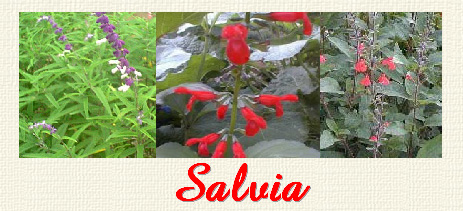|
|
|

| Salvia is a genus of about 900 species of annuals,biennials,perennials and shrubs,with some being rhizomatous or tuberous.These species are distributed worldwide in temperate and tropical climates, and usually are found
growing in rocky slopes,dry meadows, scrub,light woodlands and moist grassland.Then usually square stems bear opposite pairs of simple to pinnate,entire,toothed, notched or scalloped leaves. The flowers are two-lipped, with the upper lips being erect and hooded and the lower lips being two-toothed and spreading.The calyces are bell shaped or funnel shaped and the bracts are ovate to diamond shape. |
| Cultivation Under glass grow in well drained soiless (perlite or vermiculite),or soil based potting soil in full sun with protection from the noon heat. During the growing season water freely, and use a water-based fertilizer on a monthly basis.During the winter months water sparingly.In an outdoor environment, grow in a light, moderately fertile, humus rich, well drained soil in full sun to dappled shade.Plants in this genera should be prunned annually after blooming has subsided, or in mid to late spring as necessary to maintain appearance. |
| Propagation Propagation of Salvia can be done by three different methods.The first method is by division in spring.The next method entails root basal or softwood guttings in spring or early summer, or semi-ripe cuttings in late summer or autumn with bottom heat.The third method is through seed germination.This method is the most complex as there are differing conditions which must be applied to many species in this genera.The first obstacle which for most species must be dealt with is the very thick seed coat which must allow moisture to penetrate the outer shell in order to begin the germination process.In many species this can be accomplished through scarification which is most easily accomplished by rubbing the outer shell with sandpaper.Other groups require alternation of temperatures to mimic those predominately found in nature. These temperature variations must assimulate that which is found in the native range of the plant.For some species, the cold temps must be maintained at 40°F.(4.5°C.), for two weeks,followed by transition to a warmer climate of 70°F.(21° C.)for the balance of it's required germination period.Other species may require an even longer cold period prior to placing them in the warmer environment.There is also a group which is traditionally germinated by exposure to liquid smoke, and others which require the growth hormone GA3 (Gibberillic Acid)for pre-soaking prior to planting. In addition to the above variables, there is also the variation in light intensity and duration. Most of the species in this genera will require an abundance of light so they are traditionally planted on the surface of the soiless or soil-based media.Ideally these plants should receive a 16 hour photoperiod (light duration).Light intensity varies during the day and between different days, so it might be best to grow under artificial light which can be regulated.There are those species however that will yield a higher germination rate if placed in a dark environment for a specific period, prior to being moved to normal light conditions.A good reference for many of the species can be found in Norman C. Deno's book entitled Seed Germination Theory And Practice (June 1993). Pests And Diseases The typical pests which are found in this genera include whiteflies,aphids,mealybugs,and spider mites.Diseases which are common to this genera include rust, powdery mildew, stem rot and fungal leaf spots. © BOTRESEARCH USA 2002-2012 |